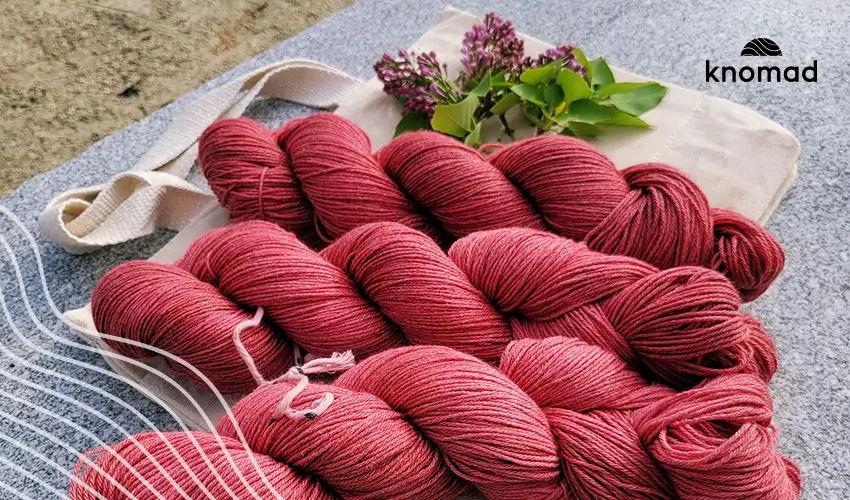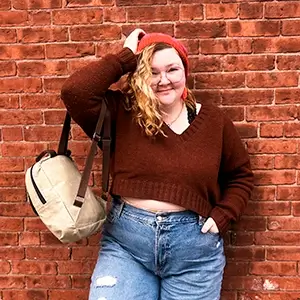Dyeing Soleil 50% Cotton 50% Superwash Merino – which dye is best?

As a New Englander, I am rarely in control of my wardrobe. Up here, we’re ruled by changeable and dare I say crotchety weather gods, who delight in vexing us by sending snow in April and 92 degree days in May. It could rain at any moment, regardless of what the sky looks like. You could be standing in still warmth at noon, and come one o’clock find yourself fighting 40 MPH winds to get back inside. What I’m saying is, you have to be flexible. And that can be difficult for a wool dye-hard (get it?) like me.
I’m a wool knitter, and I’m a wool dyer. Blends terrify me, because plant fibers and protein fibers require entirely unique chemical processes to penetrate. Most of the dyes I own are Dharma Acid Dyes, so they simply wouldn’t work on cottons, and I’m not keen on learning a whole new dye process for a fiber I honestly don’t especially enjoy knitting with (gasp!). But, being that I’m subject to the seasons, at times I’m forced to make concessions. It’s getting warm, it’s time to put the woolens away and start looking at alternative fibers, lacey motifs, and tank top patterns. Enter Soleil Fingering.
Soleil Fingering
is a finely milled 50/50 blend of fine superwash merino wool and Pima cotton. The blend of fibers is virtually undetectable to the naked eye, and unlike other wool/cotton blends I’ve sampled, it has a very fine hand. I don’t feel the “grabbiness” I associate with cotton fibers – one reason that cotton is often a no-go for me is because of how it catches on my fingers, and also how it retains water; but Soleil Fingering has a smooth, soft texture and enough wool content to provide structure, memory, and wick water (and sweat) away from the skin so it can evaporate. Add the breathability that cotton brings to the table, and we’re looking at a perfect summer yarn. Let me just say, by the way, that no one asked me to puff up this yarn! But as a habitual cotton-avoider, I’m pretty impressed.
Because I tend not to use it, I don’t have much on hand for cotton dyes, BUT, I do have two or three jars of Dharma Fiber Reactive Procion Dyes on hand for dyeing cotton fabric. So when I heard there was Soleil Fingering on the way, knowing I had a jar of Oxblood Red in both Dharma Acid and Dharma Fiber Reactive Procion Dyes, I knew right away that an experiment was in order. Let’s get right into the knitty gritty.
The question: How do acid dyes and fiber reactive (or plant fiber) dyes compare when used to dye 50/50 cotton wool?
Materials
- 6 skeins of Knomad Soleil Fingering
- 2 x 4” full hotel pans (also called chafing dishes)
- 1 x dedicated dye tongs
- 1 x dedicated dye spoon
- Gloves – one pair of rubber or two pairs disposable
- 1 x particulate mask (a respirator is preferable if available, but a disposable mask will do)
- 6 x black zip ties (or your preferred skein management tool)
- 2 x dedicated dye mixing containers
- Gram scale
- Dharma Acid Dye #440 Oxblood Red
- Dharma Fiber Reactive Procion Dye #136 Oxblood Red
- White Vinegar for Acid Dye and/or Soda Ash for Procion Dye
- Wool wash or dish soap
- OPTIONAL: Hotel pan lids (you can get by without them, just keep an eye on your water level and be prepared for your kitchen to get humid!)
- OPTIONAL: 1 or 2 dedicated dye buckets for soaking and washing
- OPTIONAL: 4 strands of light cotton yarn, or contrast colored zip ties.
- OPTIONAL: Dye rags – you won’t see them in these instructions, but they’re good to have on hand!

Prep
Needed: Yarn skeins, zip ties
Optional: 3 strands of cotton yarn, bucket
- Carefully remove the tags from your Soleil Fingering skeins.
- Don’t cut your ties by accident! It’s possible that I’m speaking from experience here, hehe.
- Open your skeins and secure a zip tie (or your preferred skein management tool) as loosely as possible around each skein. PRO TIP: Choose black or colored zip ties over clear or white. They will be easier to spot in the dye pans; clear and white will pick up the dye color and blend in.
- OPTIONAL: If you’re repeating this experiment to the letter, secure a strand of cotton yarn around the zip ties of 3 skeins. This is to mark your procion skeins so you don’t get mixed up! You might also use a different color zip tie for these skeins. I chose to add a cotton strand because I could tie them around the skein itself after they were dry.
- Presoak your bare yarn in cool to lukewarm water for twenty minutes to an hour. You can leave yarn in water up to overnight indoors in a temperature controlled environment. I usually leave mine in a bucket in the bathtub, but you could also use your sink.
Dye Set-up
Needed: 2 dye containers, dye spoon, scale, Dharma Acid Dye, Dharma Fiber Reactive Procion Dye
Optional: 1 strand of cotton yarn
For this experiment, I used the dye to fiber ratios that Dharma recommends – for acid dyes, usually 1.5% to 2%, or 1.5-2g of dye per 100g of fiber. Procion dyes are a little trickier, but fortunately Dharma has a handy Fiber Reactive Dye Yields Calculator for dyeing solid colors right on their website!
Following the recommended dye yields for each dye, I’ll be using a 2g/100g ratio for the acid dye, and 4g/100g ratio for the procion dye. Please note that these ratios take into account the specific dye colors being used, and may not work for other colors. When in doubt, check out the instructions on your dye manufacturer’s website.
- Put on a pair of clean gloves and a particulate mask. PLEASE NOTE that Oxblood Red, particularly in the acid dye, is an extremely finely milled powder. I HIGHLY RECOMMEND wearing a mask when using this specific dye, even more so than with other dyes, and especially when the dye has not yet been mixed with water. You may even wish to use eye protection, or to mix this dye outdoors to prevent it from settling around your kitchen. I promise it’s worth the trouble, though! This is my richest, most dependable red, and I use it all the time.
- Measure 6g of Dharma Acid Dye #440 into your first empty dye container. Add about 8oz of hot water and stir thoroughly.
- Measure 12g of Dharma Fiber Reactive Procion Dye #136 into your second empty dye container. Add about 8oz of hot water and stir thoroughly. OPTIONAL: drape your last piece of cotton yarn over the edge of your container to differentiate your procion dye. You can secure it with a piece of tape if you like, or differentiate with a piece of tape.
- You may remove your gloves and mask after you have finished handling and mixing your dyes.
- PRO TIP: Allow both dye solutions to sit for AT LEAST ONE HOUR. I cannot stress enough how much this helps with even dye uptake. It gives those dye particles extra time to dissolve and really become a homogenous dye solution that will not break. I let my dye solutions sit for about 3 hours, and left my yarn to soak at the same time.
OBSERVATIONS: At this stage, the two dye solutions do look quite different. The acid dye mix has a very cool, blue-toned red color (think cranberries, pomegranates, burgundies), whereas the procion dye is much warmer and orange-toned (think tomatoes, ketchup, maroons).

Dyeing
Needed: 2 4” hotel pans and lids, spoon, tongs, dye solution, yarn, soap, vinegar/citric acid/soda ash
- Set your two hotel pans on the stove and fill just over half way with lukewarm water, about 7 liters or 1.75 gal, but you don’t need to be exact.
- Put on a pair of clean gloves and a particulate mask or respirator.
- Retrieve your acid dye solution. Stir until thoroughly mixed, then pour into one hotel pan. PROTIP: If you pour your dye to one side of your pan, you can then dip your empty dye container into the clean water on the other side to swish out. No dye waste!
- Use your spoon or tongs to stir the dye solution in the pan until evenly distributed.
- Repeat the last two steps in the other pan using your procion dye solution. OPTIONAL: Move your cotton strand marker from your procion dye container to your procion dye pan.
- Retrieve 3 unmarked presoaked skeins, gently squeezing out the excess water as you remove them from their container.
- Insert the 3 skeins into the acid dye bath using your preferred method. For even dye distribution in solids, I like to lay my yarn carefully into the pan, give it a swish, then lift it out and lay it on the other side. I consider this method of submerging both sides to be one full “dip”, and I do 3 full dips per pan. Between dips, I gently pull my skeins apart and rotate them so that each skein is on the right side for one dip, the center for another, and the left for another, to ensure that the sides are evenly exposed and able to pick up dye. You may choose not to do so many steps (it’s quite the shoulder workout!), and that’s totally fine. I’d recommend at least flipping your yarn at least once, and swish it gently in the pan with your gloved fingers or tongs to allow the dye to move through it.
- Repeat the above two steps with your 3 marked skeins and your procion dye bath.

OBSERVATIONS: After inserting yarns into both pans, the colors strangely seemed to even out, and were nearly identical. Strange! I’m not a chemist or an optical engineer, so I can’t tell you why this is, but I have to assume it has something to do with the differences in the dyes and how their respective fibers reflect light.
- Cover both pans (if you have lids) and set over low heat – on my stove, I start at 3 out of 10. You can start even lower if you like, but given that Soleil’s wool is superwash, I think it’s fine to give things a bit of a kick start. You’ll want to lower the heat down to a 1 or 2 out of 10 once you start to see steam. PRO TIP: In the beginning heating phase, it’s a good idea to periodically give the water a swish to ensure even heat distribution. You can use your tongs or spoon for this, but I often will just lift a corner of the pan about an inch and set it back down, as this is enough to set the water moving in the pan.
- Allow the pan to heat at a bare simmer for an hour or so, without allowing it to bubble, until the water is mostly if not completely clear. You may have to add vinegar or citric acid to the acid dye, or soda ash to the procion dye, in order to clear the water. Add a little at a time, half cup increments for vinegar and tablespoon increments mixed into a cup of water for citric acid or soda ash, being sure to stir gently in order to distribute evenly through the pan.
- Allow your yarn to cool fully, or if you’re impatient, at least to a comfortable handling temperature.


OBSERVATIONS: Throughout the dye process, the two yarns appeared to take up dye and set at an even rate, with very little difference visible to the naked eye (it’s pretty much impossible to spot the difference in photos, so you’ll have to trust me that there’s a difference at all). I did have a little bit more difficulty getting the procion dye to exhaust, but I’m pretty sure that’s because I didn’t have any soda ash on hand. To make up for it, I just let the cooled pans continue to sit overnight. By the next morning, the water was clear enough that I felt alright moving on.
- Wash in hot but not scalding water, and rinse in water that is at least warm so as not to shock your yarn. Squeeze your skeins dry, twisting them as little as possible to do so. You may choose to roll them in a towel as with wet blocking, or spin dry them in a salad spinner or your washing machine.
- Give the skeins a good thwack if you like. I personally don’t do this on my own yarn, as it can lessen the elasticity a bit, but it does help the yarn hang nice and straight as it dries.
- Hang your skeins to dry – this time of year, I love to put them up on the porch in the sun! Usually they’re done in less than a day if I can time it right (and if the fickle weather cooperates).
Conclusion
I’m happy to report that at the end, the two skeins were truly almost identical! With this rich jewel-tone red dye, what we’ve achieved on both yarns is a faded but uniform red with a marled effect, thanks to the undyed 50% of fiber in either skein.

I feel that the procion dyed yarn has a very slightly more visible white halo, which makes sense to me, as the undyed merino fibers on this skein have a longer staple than the undyed cotton fibers on the other skein, by as much as 2 inches, but I can’t say I’d recommend one dye over the other based solely on results. I’d say go for whatever you’ll use again – if you dye a lot of wool yarns, acid dye is the way to go. If you expect to be dyeing cotton fabrics, tie dyeing, or if you’d like to try ice dyeing, go for the procion dye.

In my opinion, the marling of these well-blended fibers lends it the quality of stone-washed linen or cotton, or the worn-in look of a vintage denim, dyed through but with a halo of whitish fuzz visible when you look very close. I love the almost sun-kissed effect, and I think it makes for a very wearable solid color that would look nice on anyone, especially if you’re someone who loves bright colors but prefers to keep your wardrobe more muted. Between the fiber and dye performance this yarn has an effortlessly beachy, wind-weathered, coastal look, and would make a fantastic summer-weight cardigan, tee, tank top, swim cover-up, any kind of baby garment, or a crocheted beach tote!
Happy Making!










